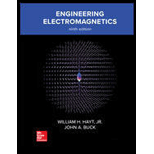
The ratio of outer radius
Answer to Problem 6.1P
The ratio of outer radius
Explanation of Solution
Calculation:
The ratio of outer radius
If they store the same energy at a given applied voltage, then the capacitances of both structures are the same. So, the length of both structure are same and they contain the same dielectric, it means the relative permittivity of both structure are the same.
The capacitance of first structure is written as,
Here,
The capacitance of second structure is written as,
The capacitances of both structures are same, so equation (1) is equal to equation (2), therefore, expression is written as,
The simplified form of equation (3) is written as,
Conclusion:
Therefore, the ratio of outer radius
Want to see more full solutions like this?
Chapter 6 Solutions
Engineering Electromagnetics
- 4. In what form is the energy of a capacitor stored?arrow_forwardA capacitor uses air as a dielectric and has a capacitance of 3 F. A dielectric material is inserted between the plates without changing the spacing, and the capacitance becomes 15 F. What is the dielectric constant of this material?arrow_forwardFind / Derive the equation for the capacitance of a spherical capacitor, consisting a spherical conducting shell of radius "b" and charge - Q concentric with a smaller conducting sphere of radius "a" and charge Q. Draw the figure.arrow_forward
- What is a dielectric material, and what does it do? a. What are 3 ways capacitance can be increased by changing the materials?arrow_forwardA parallel-plate capacitor using a dielectric material having an Pr of 2.2 has a plate spacing of 2 mm (0.08 in.). If another material having a dielectric constant of 3.7 is used and the capacitance is to be unchanged, what must the new spacing be between the plates?arrow_forward2. A parallel plate capacitor 6 mm apart, the area of each plate is 12 cm². The space between the two plates is filled with a dielectric material with K-10. If the capacitor is given a potential difference of 12 Volts, determine: a. Capacitance of capacitorb. Charge on capacitorarrow_forward
- A certain parallel-plate capacitor consists of two plates, each with area 200 cm2, separated by a 0.4 cm air gap. If the capacitor is connected across a 400-V source. Draw the diagram a. Determine the energy stored on it. b. Determine the energy stored if there is a dielectric material with constant of 2.5 inserted between the plates.arrow_forwardResearch and explain the following topics and cite examples oneach topics 1.) Capacitance of a Two parallel-plate capacitor with uniform dielectric medium.2.) Capacitance of an “n” parallel-plate capacitor having the same type of dielectric material and thickness of dielectric uniform dielectric medium.3.) Capacitance of an “n” parallel-plate capacitor having the different dielectric material and thickness of dielectric uniform dielectric medium.4.) Capacitance of a Two parallel-plate capacitor with a medium partly air.5.) Capacitance of a coaxial cable (Farad per meter).arrow_forwardB. Combination of Capacitors (connect it with a battery and LED) 1. Connect in series any 3 capacitors made in Procedure A. 2. Measure the equivalent effective capacitance of the combination. 3. Compute this theoretical value of capacitors in series using the formula 1_1, 1, 1 Crotat C* C*G, 4. Repeat steps 1 and 2 but this time connect the capacitors in parallel. Compute this theoretical value of capacitance in parallel using the formula below. Crotal = C + Cz + C, 5. Compute the percent error for both connections. Record all your observations and results in the table below. Table 2 Capacitor 1 Capacitor 2 Capacitor 3 Experimental capacitance (in series) Experimental capacitance (in parallel) Conclusions: Questions: 1. How does the area of the aluminum foil affect the capacitance if the paper capacitor? 2. How does the thickness of the paper dielectric affect the capacitance of the paper capacitors? 3. Did you get the same capacitance using different types of paper? What do you think…arrow_forward
- A.find equivalent capicitance between a and b. B.what is charge stored on equivalent capicitor.arrow_forwardPlease derive this equation for capacitance at flat band:arrow_forward.i. In a parallel plate capacitor, the cross sectional area of the plates are doubled and all other parameters remains the same. The ratio of Final capacitance to initial capacitance is found to be:arrow_forward
 Delmar's Standard Textbook Of ElectricityElectrical EngineeringISBN:9781337900348Author:Stephen L. HermanPublisher:Cengage Learning
Delmar's Standard Textbook Of ElectricityElectrical EngineeringISBN:9781337900348Author:Stephen L. HermanPublisher:Cengage Learning
